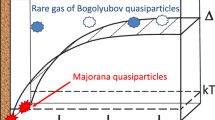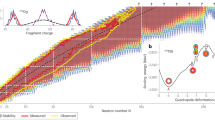Abstract
I review three sets of experiments conducted in the last decade, in which superfluid 3He was irradiated with high-energy particles and the nucleation either of vorticity or of the A–B phase transition reported. I consider how far the known atomic physics constrains possible scenarios for such nucleation, and comment on two such scenarios which have appeared in the literature, namely the “baked-Alaska” and “cosmological” (Kibble–Zurek–Volovik) models. I point out that there is a fundamental difference between the problems of nucleation of vorticity on the one hand and the B phase on the other: and that as a result, it is by no means necessary that the same scenario should describe both phenomena. In an appendix I discuss possible sinks of energy in the calorimetric (Grenoble–Lancaster) experiment, with the conclusion that it is entirely consistent with the data to assume that no vorticity at all was produced in this experiment.
Similar content being viewed by others
REFERENCES
D. Vollhardt and P. Wolfle, The Superfluid Phases of Helium-3, Taylor and Francis, London (1990).
G. E. Volovik, Exotic Properties of Superfluid 3He, World Scientific, Singapore (1992).
D. D. Osheroff, Ph.D. thesis, Cornell University (1972).
For definiteness I quote numbers for pressures close to the melting pressure. The data at lower pressures (but above polycritical) are qualitatively similar.
A. J. Leggett and S. K. Yip, in Superfluid Helium-3, ed. L. P. Pitaevskii and W. P. Halperin, North-Holland, Amsterdam (1989).
A. J. Leggett, Phys.Rev.Lett. 53, 1096–1099(1984).
D. S. Buchanan, G. W. Swift and J. C. Wheatley, Phys.Rev.Lett. 57, 341 (1986).
P. Schiffer, M. T. O'Keefe, M. D. Hildreth, H. Fukuyama and D. D. Osheroff, Phys.Rev.Lett. 69, 120–123(1992).
P. Schiffer, D. D. Osheroff and A. J. Leggett, in Prog. Low Temp. Phys., XIV, ed. W. P. Halperin and L. P. Pitaevskii, Elsevier, Amsterdam (1995), pp. 159–211.
T. W. Kibble, J. Phys. A 9, 1387–1398(1976).
The actual electroweak transition as envisaged in the Standard Model involves complications which I will not attempt to analyze here; they seem unlikely to affect the issues discussed here qualitatively.
W. H. Zurek, Nature 317, 505(1985).
P. C. Hendry, N. S. Lawson, R. A. M. Lee, P. V. E. McClintock and C. H. D. Williams, Nature 368, 315–317(1994).
M. E. Dodd, P. C. Hendry, N. S. Lawson, P. V. E. McClintock and C. D. H. Williams, Phys.Rev.Lett. 81, 3703–3706(1998).
G. Karra and R. J. Rivers, Phys.Rev.Lett. 81, 3707–3710(1998).
R. Carmi and E. Polturak, Phys.Rev. 60, 7595(1999).
R. Carmi, E. Polturak and G. Koren, Phys.Rev.Lett. 84, 4966(2000).
Yu. M. Bunkov, in Topological Defects and the Non-equilibrium Dynamics of Symmetry-breaking Phase Transitions, ed. Yu. M. Bunkov and H. Godfrin, Kluwer Academic, Dordrecht (2000) (hereafter LH99).
Yu. M. Bunkov and O. D. Timofeevskaya, Phys.Rev.Lett. 80,4927–4930(1998).
Yu. M. Bunkov and O. D. Timofeevskaya, Phys.Rev.Lett. 82, 3926(1999).
Yu. M. Bunkov, Physica B 284, 246(2000).
P. Schiffer, Ph.D. thesis, Stanford University (1993).
M. T. O'Keefe, Ph.D. thesis, Stanford University (1997) (unpublished).
M. T. O'Keefe and D. D. Osheroff, unpublished.
C. Bauerle, Yu. M. Bunkov, S. N. Fisher, H. Godfrin and G. R. Pickett, Nature 382, 332–334(1996).
This estimate is revised downwards to-3% in Ref. 27: cf. Appendix.
C. Bauerle, Yu. M. Bunkov, S. Fisher and H. Godfrin, in LH99.
V. H. M. Ruutu, V. B. Eltsov, A. J. Gill, T. W. B. Kibble, M. Krusius, Yu. G. Makhlin, B. Placais, G. E. Volovik and Wen Xu, Nature 382, 334(1996).
V. H. M. Ruutu, V. B. Eltsov, M. Krusius, Yu. G. Makhlin, B. Placais and G. E. Volovik, Phys.Rev.Lett. 80, 1465(1998).
J. C. Wheatley, Revs.Mod.Phys. 47, 415–470(1975).
A. J. Leggett, Revs.Mod.Phys. 47, 331(1975).
Here I assume that the condensation energy is proportional to Tz dn/de as in simple BCS theory; this approximation, while not exact, should be adequate for our purposes.
D. D. Osheroff and M. C. Cross, Phys.Rev.Lett. 38, 905(1997).
Use of the thermal conductivity lifetime (or 'Ltotal" lifetime, see Ref. 1, p. 26) would give values approximately a factor of 3(or 2–3) smaller.
D. H. Perkins, Introduction to Hzgh Energy Physics, Addison-Wesley, Reading, MA (1972), sections 2.1 and 2.4.
A. G. Tenner, Nuc.Instr.Methods, 22, 1(1963).
G. M. Seidel, unpublished (communicated by H. J. Maris).
Because of the release of KE in recombination processes involving neutral atoms and molecules, which was not well understood in 1963, this may be a slight underestimate: cf. Appendix A, and Ref. 37.
J. F. Ziegler, Handbook of Stopping Cross-sections for Energetic Ions in All Elements, Pergamon, New York (1980).
I will always assume that the correct rate of deposition in liquid He can be obtained by multiplying gas-phase data3' by the appropriate density ratio.
A. J. Leggett, Phys.Rev.Lett. 54, 246(1985).
As discussed in Ref. 9, section (4.3.3), the T-dependence of the 60Co data is actually fitted better if the exponent 3 is replaced by 312, but there seems no obvious theoretical basis for this choice.
Section 4 of Ref. 18 contains a number of qualitatively formulated criticisms of the BA scenario. With the exception of the analysis of p. 132, which is in effect a "back-of-envelope" version of the calculation of the ratio R,/C(T,) which is done more quantitatively in section 5 above, I believe that all of these criticisms are answered either explicitly or implicitly in Refs. 5, 9 and 44 and/or in the present paper. See especially pp. 555–6 of Ref. 5, Appendix A of Ref. 9 and subsection B.3 below.
P. Schiffer, D. D. Osheroff and A. J. Leggett, Phys.Rev.Lett. 82, 3925(1999).
T. W. Kibble and G. E. Volovik, JETP Letters 65, 102–107(1997).
S. V. Iordanskii, Zh.Eksp.Teor.Fzz. 48, 708–714 (1965). Translation, Soviet Physics JETP 21, 467-471 (1965).
J. S. Langer and M. E. Fisher, Phys.Rev.Lett. 19, 560–563(1967).
At first sight this argument would preclude the survival of any vorticity at all in the G-L experiment (where there is no counterflow). However, it is argued against this that the relaxation time against contraction may be very long at the ultra-low temperatures of this experiment.
T. Vachaspati and A. Vilenkin, Phys.Rev. D 30, 2036–2045(1984).
G. Warner and A. J. Leggett, work in progress.
I heard this idea some years ago, and believe it was attributed to S. V. Iordan-skii, but have been unable to find a specific reference.
I. S. Aranson, N. B. Kopnin and V. M. Vinokur, Phys.Rev.Lett. 83, 2600 (1999).
The essentials of the argument of this Appendix, while not previously published, have been presented at various conferences over the last five years, starting with QFS 1997.
J. W. Keto, F. J. Soley, M. Stockton and W. A. Fitzsimmons, Phys.Rev.A 10, 872–886(1974).
J. S. Adams, Y. H. Kim, R. E. Lanore, H. J. Maris and G. M. Seidel, J. Low T m p. Phys. 113, 1121(1998).
J. S. Adams, S. R. Bandlcr, S. M. Broiicr, R. E. Lanorc, H. J. Maris, T. Morc and G. M. Seidel, Phys.Lett. 341, 431(1995).
R. Mehrotra, E. K. Mann and A. J. Dahm, J.Low Temp.Phys. 36, 47(1979).
P. R. Roach, J. B. Ketterson and P. D. Roach, J.Low Temp.Phys. 34, 169 (1979).
Since the thermal excimer velocity much exceeds the pair-breaking critical ve-locity, any dramatic increase in the superfluid phase should be irrelevant.
J. S. Meyer and T. Sloan, J.Low Temp.Phys. 108, 345(1997).
Author information
Authors and Affiliations
Rights and permissions
About this article
Cite this article
Leggett, A.J. High-Energy Low-Temperature Physics: Production of Phase Transitions and Topological Defects by Energetic Particles in Superfluid 3He. Journal of Low Temperature Physics 126, 775–804 (2002). https://doi.org/10.1023/A:1013878104932
Issue Date:
DOI: https://doi.org/10.1023/A:1013878104932




